[Urban Wind Generation]
Theoretical Power Outputs, Actual Power Outputs, Individual Possibilities, National Benefits, The future
![]()
Wind power can be used to generate electricity in an urban environment. The easiest way to do this would be if everybody built a 600kW turbine on the top of his or her house.
This is quite clearly not feasible, but urban wind generation is. The University of Strathclyde in Glasgow was involved in a project to redevelop the Lighthouse building in Glasgow. The Energy Systems Research Unit was involved to show how renewable technology can be utilised. One device they decided to use was a Ducted Wind Turbine.
quicktime video
http://www.esru.strath.ac.uk
This device sits at the edge of the roof of a building and utilises the
updraft of the airflow along a building side. The air flows upwards, hugging
the building wall then enters the front of the duct. The arrows above
show the flow through the turbine. The spoiler at the top of the turbine
also utilises a PV module to increase generation from renewable energy.
The spoiler is optimised to create a pressure differential across the
duct and the PV is mounted at this angle.
The devices are relatively small with a blade diameter of 600mm so they possess very little visual impact on a building.
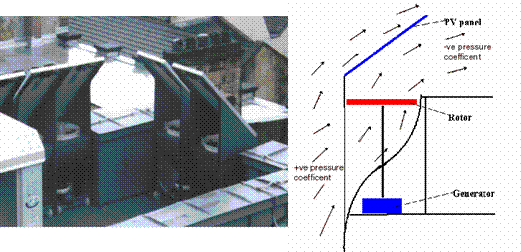
Photo of rear of Ducted Wind Turbines on Lighthouse Building
4 South Facing - 2 West Facing
http://www.esru.strath.ac.uk
These devices are suitable for an urban environment but not households.
They are more suited to office buildings and high rise buildings rather
than a small household. These devices are unlike most other common wind
turbines in the fact that they are uni-directional. As explained in the
Beginners Guide most turbines will position themselves
perpendicular to the flow of the wind. A HAWT will yaw into position and
a VAWT is always in the correct position. These turbines are fixed into
position so are dependant upon the wind blowing in the correct direction.
Because of the duct the turbine will perform favourably to a wind direction
variability of 120o. (60o to each side of perpendicular to turbine.)

The wind direction is Scotland is predominantly south-westerly so the turbines should be positioned on the South and West edges of any structures roof.
Using the devices installed at the Lighthouse an approximation on the power outputs can be made. The theory from the Beginners Guide to Wind applies here.
Air density ( ) = 1.225kg/m3
Diameter (D) = 0.6m
Wind Speed (V) = 10m/s
Cp = 0.35
Swept Area of Rotor = R2 =0.2827m2
![]()
P = 173.18W (This is the theoretical power available)
![]()
P = 60.61W (This is a realistic value of power available)
The value above shows the power available theoretically for a single ducted turbine, but in real terms they would be installed in banks along the edge of a building roof.
One single ducted wind turbine would produce 530kWh electricity per year
An average installation would probably consist of 10-ducted turbines; this would yield an annual energy production of 5308.56kWh. The installation of a PV on the spoiler would again increase the power output and if the same module from the Urban PV section is used the expected power for a bank of 10 ducted turbines would increase by 722.93kWh to 6031.49kWh per annum, assuming that each ducted turbine has one PV module installed on its spoiler, which covers an area of 0.61596m2.
The previous calculation assumes the basis that the wind speed would be constant at 10m/s for the duration of the year and that the wind would be blowing in the correct direction of the turbine. The value of power produced from these machines will be less than stated above because of these stated assumptions.
An estimation of the expected wind speeds in Glasgow could be made using data collected in Bishopton (10 miles south-west of Glasgow) (NGR = 2418E 6711N - Altitude = 59 metres - Latitude = 55:91 N Longitude = 04:53 W) every hour during 2001-
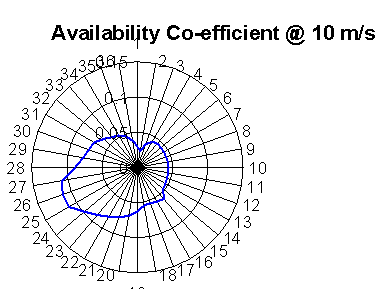
The chart shows the availability of the wind at certain angles including
the 60o availability. It clearly shows southwest to be the predominant
wind direction. The chart shows that in the southwest direction that the
wind is only available 11% of the year at 10m/s. Obviously the wind will
blow at speeds less than 10m/s but as explained in the beginners section
this would greatly reduce the power output. Again the wind will blow at
speeds greater than 10m/s and greatly increase the power output but this
would be a rare occurrence throughout the year.
The theoretical power outputs shown above are probably the upper limit
of the power expected from these ducted machines and a capacity factor
of about 25% is more realistic, knowing that for HAWT in Scotland the
capacity factor is approximately 35%, since these ducted turbines are
uni-directional.
Therefore a realistic power output from a single ducted turbine would be
(530.856 x 0.25)+ 72.293 (from PV) = 205kWh/year
We have discussed how it would not feasible to expect everyone to have a wind turbine on their roof but there is a lot of unused roof space in city centres on large office buildings and also factories roofs could provide an ideal place for wind turbines to be deployed. As we are unsure of the roof area available in Scotland, this example will demonstrate the effects of a wind turbine for every person in Scotland (5,115,000 people)
One wind turbine (530.856 x 0.25)+ 72.293 (from PV) = 205kWh/year
This would result in an electricity production of;
i) = 205(kW) x 5,115,000= 1,048,575,000kWh
1,049GWh, which is 3.3%
of Scotland's yearly electricity consumption
(Scottish Total = 32037GWh)
The introduction of ducted wind turbines could result in an annual reduction of carbon dioxide emissions in Scotland, every kWh of electricity produced from fossil fuels results in 0.97 kg of CO2
i) 0.97kg x 1,048,575,000kWh /year = 1,017,117,750 kg/CO2
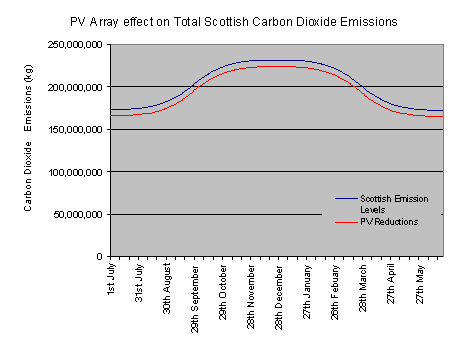
1.4 % of Total Scottish CO2 Emissions - (1.4 % of 72,300,000,000 kg)
No estimation on the cost of installation can be made, as these devices are very much in the research and development stage at this moment. The research into this field is growing as more people become interested in urban wind generation. Below are some images of ideas to utilise urban wind generation. A website exists that is only interested in the development of wind turbines for the urban environment. (www.urbanturbines.com).
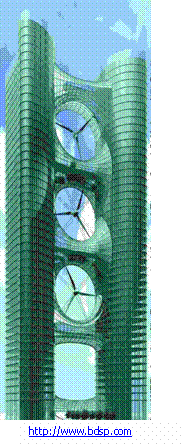
Such a technology could be deployed relatively cheaply in the future however more research has to be carried out to examine the energy production potential and where electricity produced could be used successfully. Many designers are considering the integration of wind turbines within buildings again it is not yet known how feasible this will be.
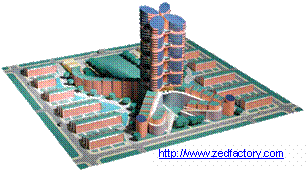
![]()
Home, Beginners Guides, Urban, Active, Passive, Passive solar, Data Acquisition, Solar water heating, Module Inclination, Wind
![]()